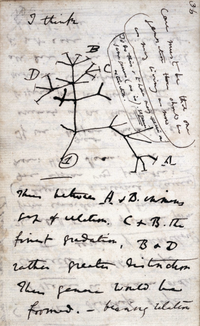
Photo from wikipedia
In metazoans, the expression of key phenotypic traits is sensitive to two- and three-way interactions between variation in mitochondrial DNA, nuclear DNA and the external environment. Whether gene-by-environment interactions affect… Click to show full abstract
In metazoans, the expression of key phenotypic traits is sensitive to two- and three-way interactions between variation in mitochondrial DNA, nuclear DNA and the external environment. Whether gene-by-environment interactions affect phenotypes in single-celled eukaryotes is poorly studied, except in a few species of yeast and fungi. We developed a genetic panel of the unicellular slime mould, Physarum polycephalum containing strains differing in mitochondrial and nuclear DNA haplotypes. The panel also included two strains harbouring a selfishly replicating mitochondrial-fusion (mF) plasmid that could affect phenotype expression. We assayed movement and growth rate differences among the strains across two temperature regimes: 24° and 28°C. We found that the slime mould's growth rate, but not movement, is affected by G × G × E interactions. Predictably, mtDNA × nDNA interactions significantly affected both traits. The inter-trait correlation across the strains in each temperature regime was positive. Surprisingly, the mF plasmid had no negative effects on our chosen traits. Our study is the first to demonstrate genetic regulation of phenotype expression in a unicellular slime mould. The genetic effect on phenotypes manifests via epistatic interactions with the thermal environment, thus shedding new light on the role of G × G × E interactions in trait evolution in protists.
Journal Title: Biology Letters
Year Published: 2023
Link to full text (if available)
Share on Social Media: Sign Up to like & get
recommendations!